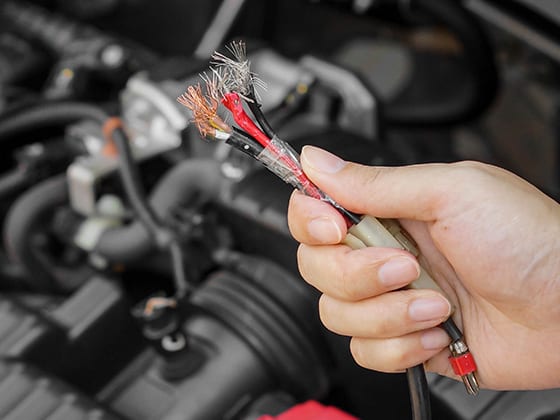 Rodents, there are few places where people live and work that the fuzzy little troublemakers won’t try to call home. Every year in Reno and Sparks our local rat and mouse populations do thousands of dollars in damage to vehicles. Indeed their gnawing can turn a precision machine into a large paperweight in less than a day. But what do the rodents get out of it and, most importantly, how can you keep them out?
Rodents, there are few places where people live and work that the fuzzy little troublemakers won’t try to call home. Every year in Reno and Sparks our local rat and mouse populations do thousands of dollars in damage to vehicles. Indeed their gnawing can turn a precision machine into a large paperweight in less than a day. But what do the rodents get out of it and, most importantly, how can you keep them out?
Why Rats and Mice Like Cars
There are many things which draw rodents to vehicles. Rodents like warm, dark places to shelter in or call home. During the winter here in Reno and Sparks, your vehicle becomes particularly inviting. And cars are certainly a convenient place for hiding from most of their predators. Insulation which protects the cab from the heat of the engine is prime nest-building material. Them occupying a vehicle as bad enough, but rodents cause the most damage to vehicles with their teeth.
A rodent’s teeth grow continuously throughout their life. They must constantly gnaw to keep their teeth sharp and prevent them from growing too long for the rodent’s mouth. A vehicle’s hoses, lines, and wires are preferred gnawing material for rodents. They commonly travel along the walls of a vehicle’s engine compartment, chewing through obstacles like wiring and hoses. Rodents often gnaw on wires in hidden and hard to reach places making troubleshooting more difficult. When they don’t chew right through wires, the newly exposed wires will short out. The little critters don’t really mean any harm but their chewing can result in an expensive trip to a Reno or Sparks repair show Like Wayne’s Automotive Center.
Signs You Have Rodents Under The Hood
Rats and mice aren’t subtle when they take up residence in and around your car. When you pop the hood you will find dusty paw prints, droppings, scratches, and signs of gnawing. If they are nesting in your vehicle you may find caches of food and scattered trash. With all the damage rodents can do it’s best to keep them out if you discover they have been in or around your vehicle.
How To Keep Rodents Out of Your Vehicle
There are many ways for Reno and Sparks drivers to discourage the persistent little vermin. Most work best in combination with each other. The easiest way is to park your car in a garage (not an option everyone has). If they are in the garage already, make sure to store pet food in secure places first and then seal up any rat or mouse-sized entrances. Rodents have a great dislike for open spaces, particularly well-lit ones because it leaves them exposed to predators. Propping up the hood (even when parked overnight) will make the engine compartment less inviting. Adding light will provide an additional deterrent.
For cars parked outside, removing brush and other debris near where you park the vehicle is as discouraging as propping up the hood. Not parking under trees if possible ensures vermin lack ready made leaf paths to your vehicle. Some drivers will block entrances to the engine with metal screens to deter access.
Pets make for excellent vermin control. Though rodents will sometimes seek out your vehicle to shelter from your pets. Should they do so, some particularly determined dogs can damage your vehicle in their loyal efforts to catch the little intruders. Cats may climb into your vehicle in pursuit of their prey. Be sure you know where your cat is before you start your car.
Electronic Deterrents
Reno and Sparks residents have a host of battery operated pest deterrents available to them which can be used in their car. Ultrasonic and strobe rodent-repelling devices are most effective. Most electronic deterrents only last as long as it takes for rats and mice to grow tolerant of them. The ultrasonic devices only last as long as it takes rodents to realize they are harmless. Strobe light devices last longer because they disrupt the darkness the rodents seek.
Predator Scent Based Deterrents
One of the most effective ways is to make your car smell bad or frightening (to the rodents at least). Why smell instead of taste? Because rodents like rats and mice can suck their cheeks in to prevent whatever they’re gnawing on from getting in their mouth. On the other hand, they have very sensitive noses they use to track down food and to detect predators.
Rodents do everything they can to avoid predators and the mere scent of one usually sends them scurrying for cover. Scattering tufts of human, dog, or cat hair around where you park the car or about the engine compartment will act as a deterrent. Place the hair tufts in places where they won’t blow away and avoid areas which get hot. Replace hair inside the engine compartment regularly. Doing so prevents the scent from growing old. Reno and Sparks drivers can also scatter powdered fox urine around where they park their car.
Another predator scent based solution is using snakeskin. Snakes are one of a few predators which can and will follow mice and rats into their hiding places. Mice and rats instinctively abandon places where a snake has recently been. Freshly shed snakeskin is an effective general deterrent. Placing a freshly shed snakeskin in your garage or someplace secure under the hood will help keep rodents at bay. You don’t have to own a snake to use this method, just drop by any pet store which carries snakes and ask. The pet store would just toss the skin anyways.
Other Scent Based Deterrents
For other scent-based deterrents, you can use cedar wood, mothballs, and peppermint oil. The scent from them overwhelms rodents rather than frightening them. When using cedar wood you can place a section the width of your tires on top of each tire. You should place mothballs in a nylon sock on top of each tire or a bucket under the engine. Be sure to remove either cedar or mothballs before you drive. In the case of mothballs removing them before you drive also prevents you from breathing in their dangerous fumes. Be careful of where you put mothballs in your engine compartment as they are a fire hazard and corrode metal.
Many mice dislike the scent of peppermint oil. Cotton balls with a few drops of peppermint oil applied and put in places where they won’t fall out help drive away some mice. Tying small bags of cotton balls to places they won’t stay to ensure more coverage. Keep the cotton balls away from anything which gets hot. While strong scented, the cotton balls will need new peppermint oil every couple days.
Chemical Deterrents
Two effective chemical based deterrents both use capsaicin to deter vermin. Capsaicin is what makes many peppers hot, it is also a potent irritant. Pure capsaicin will cause a strong burning sensation to skin, eyes, and mucous membranes exposed to it. Honda produces a capsaicin-treated tape (part number 4019-2317) which is sold through Honda dealers and online. Wrapping repaired or existing wires in the tape effectively deter rodents from chewing on them. This tape lacks the painful odor one would expect of a capsaicin product but prolonged skin exposure will cause burning. You can imagine what happens to a rodent’s skin and sensitive nose when they attempt to chew on the tape.
Other than the tape, spraying the wires in your engine with pepper spray has proven effective. You will need to reapply the pepper spray every six months. Only apply outdoors in well-ventilated areas. Duct tape a laminated sign under the hood warning that wires and other parts are coated in pepper spray. Doing so will save your mechanic from a nasty surprise if they touch their face after working on your car.
Traps and Lethal Solutions
Old and proven methods of dealing with rodents, traps offer more concrete proof of their success. Placing them on or near your tires denies rodents their primary source of ingress. Snap traps are always effective. Bait with peanut butter for best effect. When you use snap traps, be mindful the bait can draw pets too. Sticky traps can catch more than one mouse at a time, are easily disposable and be secured in places under the hood. However, a live rat in a sticky trap can be dangerous. For those not interested in killing mice and rats there are have-a-heart traps. These will require you to relocate the tiny troublemakers to a great distance away to make sure they don’t come back. Poison use is discouraged, as the poison poses a threat to wild predators and domestic animals which prey on rodents.
Using one or several of these methods together is often enough to deter. If rodents do damage your vehicle, the friendly pros at Wayne’s Automotive Center in Sparks are here to get you back on the road again.

